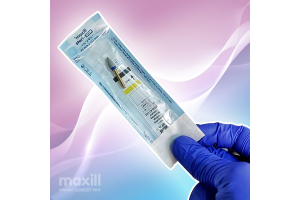Diamonds are a DDS’s Best Friend: The Ultimate Guide to Diamond Burs
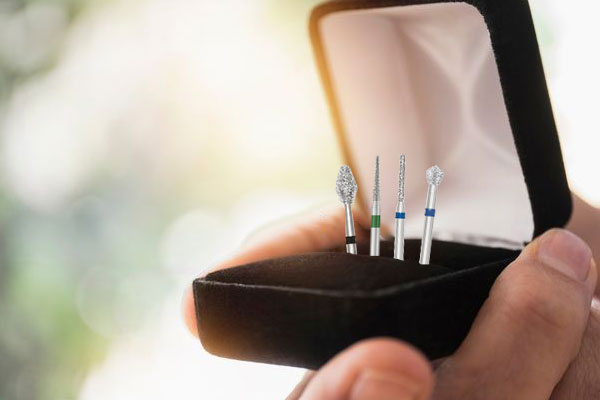
Before being an RDH, I was a CDA and then a CPDA for 4 years.
I oversaw ordering burs, sterilizing burs, and storing them in bur blocks in an official bur drawer.
These were the years when a loose unpackaged sterile burs in a bur block was acceptable in infection prevention and control.
I quickly realized that for the dentist the bur drawer was the equivalent to a jeweller displaying jewels through a glass cabinet.
On every bur block, there was a perfect jewel the dentist would need to perform dental masterpieces of artwork!
Each bur had its purpose.
How thrilled the dentist was when the perfect lineup was pre-anticipated for each procedure.
Every dental assistant knows their dentist's lineup of burs.
When another dental assistant steps in or if a hygienist needs to get a bur for the dentist, they quickly go to the dental assistant and ask; ‘What bur does the dentist want?’
Like magic, the dental assistant knows ASAP what that favorite bur is.
maxill has done its research in listening to the needs of the dentist for what constitutes a quality bur and is proud to announce their new lineup of burs called Ohio Forge.
The finesse of dentistry includes selecting the right tools for each specific task.
It is not new that a dentist can only perform as good of a cavity prep, crown prep, veneer prep, or even an occlusal adjustment as the bur style and sharpness that is being used.
No dentist will ever want to use a dull bur.
Ironically, one of the smallest pieces of equipment in the dental office is the bur, but it has one of the largest impacts on the quality of work the dentist performs.
Striving for high-quality dentistry that delivers optimal client outcomes requires a vast selection of burs in varied materials and different shapes to be efficient and effective.
Most dentists will have their favorite diamond bur shape but will also have other various shapes on standby.
Diamond burs will 100% be found in the jewelry cabinet of the dentist.
Diamond burs are manufactured with a sturdy stainless-steel frame coated with high-quality diamond powder in a variety of abrasive levels.
They are available in varying shapes, diameters, lengths, and textures all in a friction grip style with ease of use in any high-speed dental handpiece.
I still remember how happy the dentist was when he had the full lineup of all shapes of diamond burs.
The Ultimate Guide to Diamond Burs
Shapes of Diamond Burs:
There are many different diamond bur head shapes available.
Each shape characteristic makes each bur different and appropriate for a particular task.
Operative diamond burs have deep and wide flutes to allow for more aggressive enamel cutting.
These burs will usually be straight-bladed or crosscut.
Trimming and finishing burs will have more blades that are closer together and much shallower making them perfect for fine finishing and polishing.
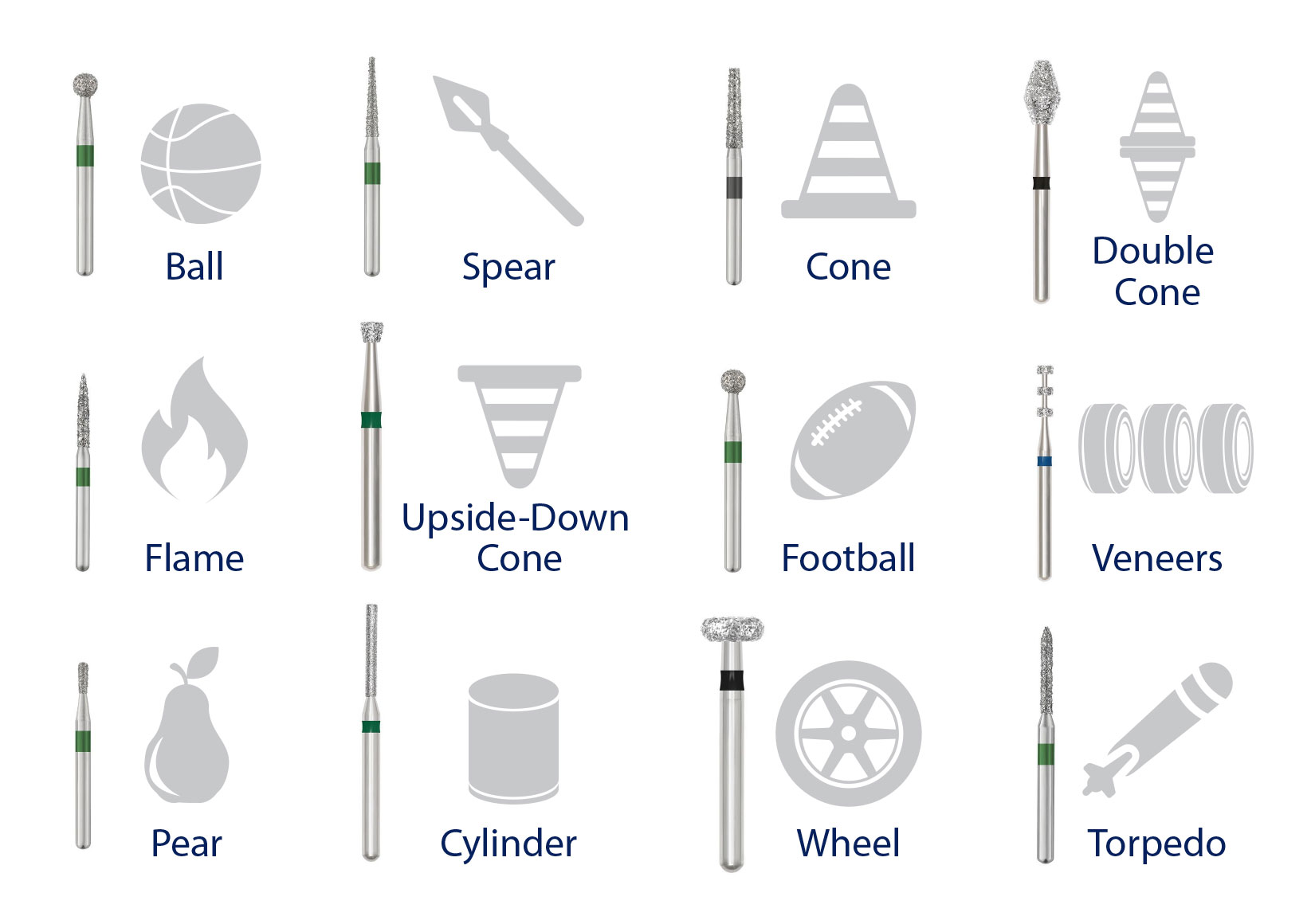
The 6 Most Common Shapes of Diamond Dental Burs and Their Uses:
- Football, Pointed Football: Diamond burs that fall into this category, most often used for cutting through porcelain and polishing. They are rounded-shaped burs that are commonly used for the preparation of palatial areas and occlusal reduction. These diamond burs are also used for cavity preparation as well as crown and bridge preparation.
- Mosquito Nose, Needle, Christmas Trees, and Interproximal: The pointed-shaped ends on these diamonds allow delicate interproximal cutting. Effective on buccal and lingual surfaces in breaking contact. Needle burs are commonly used for occlusal reduction, cavity preparation, as well as crown and bridge preparation
- Round, Round Extended, and Pear: Round and pear diamond burs come in many assorted sizes and feature a smooth rounded shape that eliminates sharp corners. They are designed for easy initial entry. Using a round diamond bur at a slower speed removes only a minimal amount of dental hard tissue while more effectively removing the softer areas of decay.
- Flat End Taper, Round End Taper, and Modified Taper: Flat End Tapered diamond burs provide flat floors and divergent walls for inlay and onlay preparations. Flat end Tapered dental burs are commonly used for crown and bridge preparation. Round end taper diamond burs are useful for common ceramic and gold crown preparations.
- Modified Beveled Cylinder, Round End Cylinder, Bevel Cylinder, Modified Round End Cylinder: The straight sides of these burs make them a suitable alternative to a file, especially when removing large amounts of material. Large-diameter cylinder burs (up to 1/2” dia.) are primarily used for grinding the insides of ring shanks. Also available with a rounded end.
- Wheel and Tri-Wheel Depth Markers: Similar to a cylinder bur, but with a much lower profile. These diamond burs have cutting flutes along their outside edge as well as the top surface. They are perfectly suited for depth cutting. Wheel and tri-wheel depth markers help to insure proper reduction of the tooth for veneers.
The Classification of Diamond Bur Abrasive Level According to Band Colour:
Diamond burs have five different abrasive levels.
Based on the abrasive level names, it is easy to see what task the diamond bur will perform.
The super-coarse and coarse are relied upon for reducing the tooth (example: shaving it down in a crown prep).
These are ideal as retention areas for the next step of letting dentists cement a crown.
On the other hand, the super-fine and fine are suited for grinding and polishing (example: occlusal adjustment and/or finishing steps of a composite restoration).
Whether the procedure requires a super coarse diamond bur for cutting properties or a very fine diamond bur for precision shaping and polishing, maxill’s Ohio Forge Diamonds offer a trusted performance level to deliver optimal dentistry in striving for excellence in individualized client care.
Diamond Bur Abrasive Level According to Band Colour:
- Super-coarse (Black)
- Coarse (Green)
- Medium (None or Blue)
- Fine (Red)
- Extra Fine (Yellow)
- Super Fine (White)
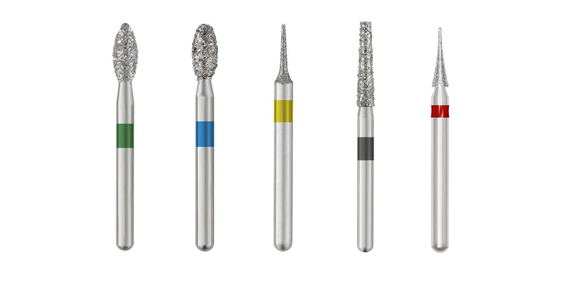
Single-Use Diamond Burs
Single-use diamond burs save time because they don’t have to be sterilized. Because they are disposed of after each use, single-use diamond burs also help prevent infection by eliminating the chance of cross-contamination between patients.
Ohio Forge Single-Use Diamonds offer quality and consistency providing the feel of a new diamond cut with each client therefore significantly increasing the preparation quality and preciseness.
All Ohio Forge Single-Use Diamonds are sold in rolls of twenty-five individually pre-sterilized diamonds. A sterile bur is ready for immediate use upon arrival at your dental office. maxill’s single-use diamonds meet the dental regulatory infection prevention and control standards in observing the manufacturer's instructions for use of a critical single-use item.
Multi-Use Diamond Burs
For some practices, multi-use diamond burs are appropriate.
Reusing diamond dental burs can be very cost-effective, especially if the cost of disposable burs rises.
Because these burs can last through several procedures, they are of higher quality than what is seen in single-use only dental burs.
Reusable burs have an environmental impact that is 40 % less than burs used on a disposable basis.
Ohio Forge Multi-Use Diamonds are designed with a dense 3-layer uniform diamond matrix that enables a greater number of diamond particles to be in direct contact with the tooth surface.
Providing the clinician with an effective and efficient bur delivering a smooth feel, superior cutting efficiency, and longevity of multiple uses.
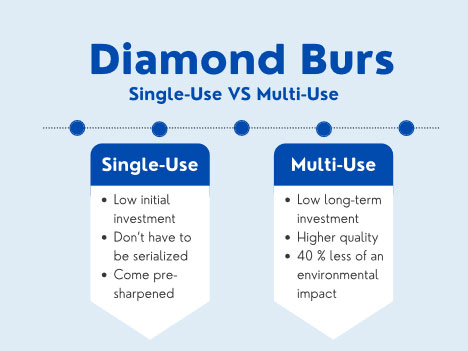
Zirconia Cutting Diamonds
Finally, the Zirconia cutting diamond bur must be mentioned.
The Ohio Forge Zirconia Cutting Diamonds are made using an advanced bonding process with fine-grit synthetic diamond particles that enhance particle coverage.
This process provides strength, durability, and superior cutting efficiency.
A high percentage of crowns have zirconia copings and require a bur that will provide a trusted level of performance allowing faster completion of the preparation.
Quickly accessing or removing a zirconia crown with no compromise on the quality of care while saving valuable chair time and cutting material costs is important to any dental office.
To Sum It Up
There is a level of dental assistant pride when they can choose the perfect diamond bur for the dentist to do the job.
There are many different diamond bur shapes available.
Each shape characteristic makes each bur different and appropriate for a particular task.
Diamond burs also have five different abrasive levels that are identifiable by the color band on the bur.
It is easy to see what task the diamond bur will perform based on the coloured band.
Finally, there are single-use and multi-use diamond burs.
The diamond bur plays a crucial role in any dentist’s tray setup.
In paraphrasing a common cliché: diamond burs are a dentist’s best friend!
Sources:
Comparative life cycle assessment of reused versus disposable dental burs



